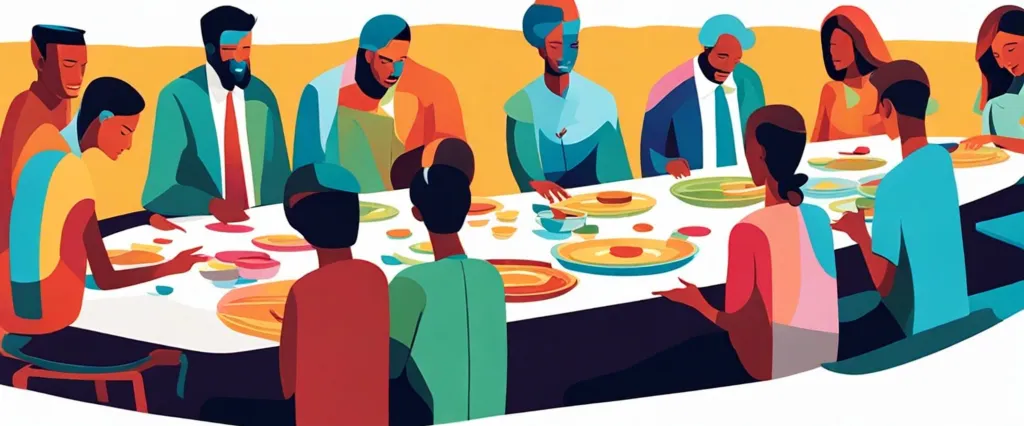
In today’s fast-paced and relentlessly evolving world, leadership has become more crucial than ever. As organizations strive for success, they often turn to influential books for guidance, seeking wisdom from renowned authors who have studied and dissected the complexities of effective leadership. Two such books that have gained immense recognition and widespread acclaim are “Leaders Eat Last” by Simon Sinek and “The Fifth Discipline” by Peter M. Senge.
Both Sinek and Senge present profound insights into the art of leadership, exploring the practices and principles that set exceptional leaders apart from the rest. While their approaches may diverge in certain aspects, their core message converges on the importance of cultivating a nurturing and inclusive environment in order to foster growth and unleash the potential of individuals and organizations.
In “Leaders Eat Last,” Sinek delves into the fascinating dynamics of leadership by drawing inspiration from biology, anthropology, and evolutionary psychology. He asserts that the most successful leaders are those who prioritize the well-being and success of their teams above their own aspirations. By establishing a culture of trust, empathy, and shared purpose, leaders can create an environment that promotes collaboration, innovation, and ultimately achieves long-term success. Sinek’s captivating storytelling style combined with his profound observations makes “Leaders Eat Last” a compelling read for leaders seeking to create a lasting impact.
On the other hand, Peter Senge’s “The Fifth Discipline” takes a slightly different approach to leadership, as it focuses on the concept of the learning organization. Senge argues that in order to thrive in today’s knowledge economy, organizations must become adept at learning, adapting, and innovating. Drawing heavily from systems thinking, Senge presents a comprehensive framework for creating a learning organization that fosters continuous improvement, where individuals are encouraged to develop their skills and collaborate across disciplines. By dispelling the myth of isolated mastery and embracing the power of shared knowledge, Senge asserts that organizations can navigate the challenges of an interconnected and turbulent world with agility and resilience.
Despite their differences in methodology and emphasis, both Sinek and Senge converge on the importance of establishing a strong sense of purpose and creating an environment that catalyzes growth and collaboration. Through an exploration of the fundamental principles of leadership, these two books offer valuable insights for leaders aspiring to cultivate thriving organizations and create a lasting impact.
In this comparative study, we will delve deeper into the ideas presented by Sinek and Senge, analyzing the strengths and weaknesses of their respective approaches and examining how they contribute to our understanding of effective leadership. By juxtaposing the concepts, methodologies, and real-life examples provided by both authors, we aim to glean a comprehensive understanding of their visions of leadership and the valuable lessons they offer to leaders striving for excellence in today’s dynamic world.
Brief Summary of Two Books
Leaders Eat Last by Simon Sinek
“Leaders Eat Last” by Simon Sinek explores the concept of leadership and how having a supportive social structure within organizations is crucial for success. The book emphasizes the idea that true leaders prioritize the well-being and success of their team members above their own.
Sinek argues that modern workplaces often lack the necessary trust and cooperation needed for a team to thrive. He suggests that a successful leader acts as a “circle of safety,” fostering an environment where individuals feel secure and valued. This, in turn, encourages greater collaboration, innovation, and productivity.
Drawing from examples in the military and successful companies, Sinek highlights the importance of creating a culture of empathy, trust, and servant leadership. He delves into the physiology behind good leadership and explains the effect of hormones like oxytocin, serotonin, and dopamine on team dynamics. Sinek also emphasizes the consequences of toxic leadership and the negative impact it can have on individuals and organizations.
Throughout the book, Sinek provides practical strategies and insights for leaders to become more empathetic, supportive, and inspiring. He emphasizes the significance of building strong relationships, establishing clear expectations, and fostering a sense of purpose to create an environment where people feel valued and motivated to give their best.
Overall, “Leaders Eat Last” encourages leaders to prioritize the well-being of their team members, nurturing a culture of trust, collaboration, and shared success.
The Fifth Discipline by Peter M. Senge
“The Fifth Discipline” by Peter M. Senge is a management book that focuses on developing a systemic way of thinking to tackle complex problems and improve organizational performance. The central concept of the book is the “learning organization,” which refers to an organization that continuously learns and adapts to its environment.
Senge explores five disciplines or practices that are crucial for building a learning organization: personal mastery, mental models, building shared vision, team learning, and systems thinking. Personal mastery involves individuals continuously developing their skills, improving their thinking abilities, and aligning their values with a shared vision. Mental models are the assumptions and beliefs that shape how individuals perceive the world, and Senge urges readers to identify and challenge these mental models to foster learning.
Building shared vision involves creating a compelling goal or purpose that motivates and aligns the entire organization. Team learning emphasizes collaboration and dialogue among team members to harness collective intelligence. Lastly, systems thinking, the most essential discipline, encourages people to see the world as interconnected systems, rather than isolated events. It involves understanding the dynamics and interconnectedness of complex systems and their unintended consequences.
Throughout the book, Senge offers numerous real-world examples and practical tools to apply the five disciplines. He discusses how organizations can cultivate a learning culture, break down organizational silos, and design effective feedback loops to continuously learn and improve.
Overall, “The Fifth Discipline” provides a holistic framework and practical guidance for organizations seeking to develop the capacity for continuous learning, adaptability, and long-term success in an ever-changing world.
Comparison between Two Books

Similarities in Collaboration
Both “Leaders Eat Last” by Simon Sinek and “The Fifth Discipline” by Peter M. Senge emphasize the importance of collaboration in achieving success and creating a positive working environment. Here are the similarities in their approach to collaboration:
1. Employee Engagement: Both books emphasize the need for leaders to engage employees in the decision-making process and involve them in creating a collaborative culture. Sinek and Senge argue that people are more committed and productive when they feel like they have a say and are valued in the organization.
2. Trust and Psychological Safety: Collaboration requires trust and psychological safety within a team or organization. Both authors highlight the significance of creating an environment where people feel safe to voice their opinions and take risks without fear of punishment or negative consequences. This leads to increased creativity, idea-sharing, and problem-solving abilities.
3. Systems Thinking: “The Fifth Discipline” emphasizes the importance of looking at the bigger picture and understanding how different components of an organization are interconnected. Collaboration requires an understanding that no individual or department can work in isolation, and that collective efforts and interdependency are crucial for success. Similarly, Sinek emphasizes the need for leaders to focus on creating a culture of collaboration across all levels of the organization.
4. Shared Vision and Purpose: Collaboration is facilitated by a shared vision and purpose that brings people together. Both books stress the importance of clearly communicating the organizational mission, values, and goals to foster collective buy-in and alignment. This shared understanding creates a collective sense of purpose, motivating employees to collaborate towards a common objective.
5. Empathy and Listening: Both authors emphasize the importance of empathetic leadership and active listening in promoting collaboration. Leaders who genuinely listen to their employees’ ideas and concerns create an inclusive environment that encourages open communication, fosters trust, and enhances collaboration.
6. Learning and Continuous Improvement: Collaboration is seen as a means to learn from each other and continuously improve as a team. Both books highlight the significance of fostering a learning culture and providing opportunities for individuals to develop their skills, share knowledge, and learn collectively through collaboration.
Overall, both “Leaders Eat Last” and “The Fifth Discipline” emphasize collaboration as an essential element for creating a successful and sustainable organization. They both argue that collaboration leads to increased employee engagement, trust, shared vision, and learning, ultimately propelling organizations towards growth and success.
Divergences in Collaboration
Both “Leaders Eat Last” by Simon Sinek and “The Fifth Discipline” by Peter M. Senge emphasize the importance of collaboration in these respective books. However, there are some notable divergences in the way these authors approach and discuss collaboration.
In “Leaders Eat Last,” Sinek explores the concept of leadership and its impact on fostering a collaborative environment within an organization. He argues that true leaders prioritize the needs and well-being of their teams above their own, creating a sense of safety and trust that is essential for collaboration. Sinek emphasizes the role of leaders in setting a positive example by creating a Circle of Safety in which teamwork and collaboration can thrive. He believes that collaborative workplaces are built on the foundation of trust and empathy.
On the other hand, Senge’s “The Fifth Discipline” looks at collaboration from a broader systemic perspective. He introduces the concept of the “Learning Organization,” which embodies a collective approach to problem-solving and collaboration. Senge argues that in order to thrive in an interconnected world, organizations must foster a culture of shared vision, personal mastery, mental models, team learning, and systems thinking. Collaboration, in Senge’s view, is not limited to a few leaders but should be ingrained throughout the entire organization, involving every individual at all levels.
While both books stress the importance of collaboration, their divergences lie in their focus and approach. Sinek mainly discusses collaboration within the context of leadership, emphasizing the role of leaders in enabling a collaborative culture. He highlights who should take the lead in fostering collaboration and the impact of leadership behavior on a team’s willingness to collaborate.
In contrast, Senge takes a more holistic approach, exploring collaboration as an intrinsic aspect of a learning organization. Collaboration, according to Senge, should permeate the entire organization, where individuals across all levels engage in continuous learning, team learning, and systems thinking to address complex challenges together.
In summary, “Leaders Eat Last” mainly focuses on how leaders can foster collaboration, while “The Fifth Discipline” delves deeper into the systemic aspects of collaboration within a learning organization. Both books offer valuable insights, but by differentiating their approaches to collaboration, readers can gain a more comprehensive understanding of its significance in organizations.

Conclusion
Both “Leaders Eat Last” by Simon Sinek and “The Fifth Discipline” by Peter M. Senge are highly regarded books in the field of leadership and organizational development.
“Leaders Eat Last” focuses on the importance of creating a workplace culture that values employee well-being and fosters a sense of trust and collaboration. Sinek emphasizes the importance of leaders taking responsibility and putting the needs of their team members first. The book provides insightful examples and practical advice on creating a supportive work environment.
On the other hand, “The Fifth Discipline” explores the concept of the “learning organization” and the five disciplines required to build one: personal mastery, mental models, shared vision, team learning, and systems thinking. Senge discusses the challenges faced by organizations and provides strategies to develop a culture of continuous learning and improvement.
Both books offer valuable insights for leaders and executives, but they approach the topic from different angles. Your choice between the two depends on what aspects of leadership and organizational development you are most interested in. If you are focusing on creating a healthy work environment and understanding the impact of leadership behaviors, “Leaders Eat Last” might be a better fit. However, if you are more interested in organizational learning and developing systems thinking skills, “The Fifth Discipline” would be the more suitable choice. Ultimately, it depends on your specific interests and objectives.



